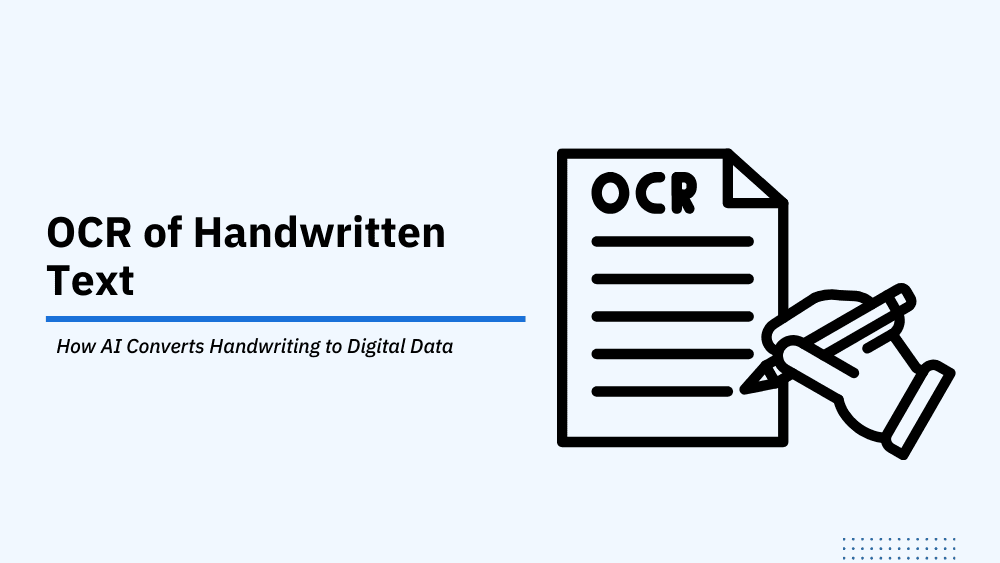Handwriting OCR has reached nearly 95% accuracy for legible text, according to Adobe’s internal benchmark reports on Adobe Scan. Yet, businesses still lose hours manually entering handwritten records. OCR of handwritten text uses AI to automate this process — especially when integrated with modern intelligent document processing platforms.
- Can AI truly recognize different handwriting styles accurately?
- What if the handwriting is cursive or untidy — will OCR still work?
- Can businesses rely on AI OCR for compliance-heavy documents?
These questions arise because most traditional OCR tools weren’t designed for handwritten inputs. That’s changed. Newer solutions combine machine learning and computer vision to extract information from handwritten notes, scanned forms, and even medical prescriptions.
What is OCR of Handwritten Text?
OCR of handwritten text is the process of converting text written by hand on paper or other media into digital text that can be searched, stored, and processed. This involves more than simply capturing an image — it requires extracting meaningful characters and words from it, which is more difficult than standard OCR.
The irregularities in handwriting make recognition highly variable, and therefore, more computationally intensive. In contrast to printed text, where shapes are uniform and predictable, handwritten characters often merge, vary in size, and can even include flourishes or shorthand.
OCR technology designed to handle this must learn from many samples and adapt in real time. This is where artificial intelligence makes a significant difference. Through deep learning and pattern recognition, AI-powered OCR systems can distinguish characters, even if they are irregular, slanted, or poorly formed.
Traditional OCR systems largely fail at this task because they are rule-based and template-dependent. AI-powered handwriting OCR can adjust dynamically. It doesn’t require predefining every possible variation.
This shift in capability opens doors to digitizing archives, processing handwritten forms, and extracting valuable insights from previously untapped data sources.
To further understand how this works, you may also want to explore what is data extraction and how it complements OCR capabilities.
How Does Handwriting OCR Work?
Handwriting OCR follows a multi-stage process designed to handle the variability of human writing. It begins with image capture, followed by enhancement, segmentation, character recognition, and text export. Each phase has its own technological components that contribute to accuracy.
Once the document is scanned or photographed, preprocessing cleans the image — correcting skew, removing noise, and enhancing contrast. The next step is segmentation, where the system breaks the image into lines, words, and characters.
This is harder with cursive writing where characters connect, so AI models use learned patterns to make predictions. Character recognition then involves matching each segment to known examples. Deep learning models trained on vast datasets can recognize thousands of handwriting styles.
These models consider stroke order, spacing, and context to reduce errors. The final output is exported into formats like searchable PDFs, Word documents, or structured JSON.
Even after recognition, post-processing algorithms step in. These check spelling, apply natural language rules, and flag uncertain words for human review. All of this results in a usable digital document — significantly more reliable than manual transcription.
For related insights, check out how KlearStack supports extracting data from PDFs, often used alongside handwriting OCR.
Practical Applications of Handwriting OCR
Handwriting OCR has evolved from a niche function into a mainstream business tool. Industries that still rely on pen-and-paper processes now have a way to bridge analog and digital workflows. It finds utility in sectors where documents are either historical, handwritten on forms, or gathered in the field.
In healthcare, patient intake forms, prescriptions, and handwritten charts can be digitized instantly. For insurance, field reports and claims filled out by hand are automatically ingested. Logistics operations convert delivery receipts, logs, and driver notes without delay. Legal firms use it for court transcripts, contracts, and affidavit reviews.
Even education sectors are digitizing handwritten exams and student feedback. Across all of these, the goal is the same — reduce manual entry, improve access to information, and speed up decision-making. Where previously documents had to be keyed in manually, now data becomes instantly accessible, reducing operational friction.
This shift also supports downstream analytics. Structured data enables better reporting, integration with ERPs and CRMs, and compliance documentation.
Businesses not only save time but unlock insights that were buried in paper. Relatedly, efforts in document digitization are further enhanced with handwriting OCR.
Challenges in OCR of Handwritten Text
1. Writing Style Diversity: OCR struggles with unique strokes, angles, and forms across writers.
2. Cursive and Connected Letters: Characters that merge complicate segmentation and increase recognition errors.
3. Poor Image Quality: Blurry or faded scans reduce character clarity and hamper accurate extraction.
4. Cluttered Backgrounds: Ink smears, folds, or dirty paper introduce noise that disturbs OCR models.
5. Language-Specific Traits: Accents, diacritics, or special symbols create confusion in multilingual scenarios.
6. Inconsistent Layouts: Non-uniform spacing or handwritten annotations pose layout segmentation issues.
7. Training Limitations: Limited datasets for niche languages or poor handwriting styles affect output.
8. Post-Correction Gaps: Without spellchecks or language models, OCR results can remain flawed.
9. Processing Power Requirements: AI models require GPU and server resources to train and run effectively.
10. Demand for Real-Time Output: Business users need fast, reliable output with little room for delays.
Best Practices for Better OCR Accuracy
1. Use Block or Capital Letters
OCR models perform better with uppercase characters than cursive or stylized fonts.
2. Maintain Consistent Spacing
Spacing between words and characters should be even to help accurate segmentation.
3. Write on Lined or Grid Paper
Straight baselines help keep the text aligned, reducing OCR confusion.
4. Avoid Mixing Letter Cases
Consistency in case format increases recognition efficiency.
5. Use Dark Ink on Light Paper
Contrast improves scan quality and model visibility.
6. Scan at 300 DPI or Higher
Higher resolution provides more clarity, reducing pixel-related misreads.
7. Prevent Smudges or Folds
Clear and flat documents make OCR results more dependable.
8. Ensure Adequate Lighting
Avoid shadows and glares during scanning to preserve image integrity.
9. Avoid Text Overlaps
Drawings or side notes should not interfere with the main text body.
10. Enable Post-Processing Reviews
Human or automated checks enhance final document accuracy.
Comparing Traditional OCR vs AI-Powered OCR for Handwriting
| Feature | Traditional OCR | AI-Powered Handwriting OCR |
| Text Type | Printed text only | Handwritten and printed |
| Learning Ability | Rule-based | Learns from new data |
| Cursive Recognition | Not supported | Supported |
| Template Dependence | High | Low |
| Context Awareness | No | Yes |
| Accuracy with Variability | Poor | High |
| Real-Time Adaptability | No | Yes |
| Output Flexibility | Limited | Multiple formats (JSON, PDF) |
| Training Requirements | Minimal | Requires training data |
| Best For | Uniform documents | Complex, mixed layouts |
To understand where OCR fits within broader systems, explore how document processing handles various file types.
Data Fields Extracted from Handwritten Text Using OCR
OCR tools today can extract a variety of structured fields from handwritten content. This includes:
Identifiers: Names, Dates of Birth, PAN numbers, Passport numbers
Transaction Details: Amounts, Invoice Numbers, Dates, Payment References
Address Information: Street names, Postal codes, City, State
Itemized Content: Product names, Serial numbers, Descriptions
Instructions or Comments: Free-form notes, signatures, special remarks
This makes OCR highly valuable for turning paper-based processes into structured digital workflows.
Types of Handwritten Documents in BFSI and Shipping & Logistics
BFSI Sector
- KYC Forms
- Cheque Slips
- Loan Applications
- Insurance Claims
- Bank Mandates
Shipping & Logistics
- Delivery Acknowledgment Notes
- Shipping Manifests
- Bill of Lading
- Customs Declaration Forms
- Driver Logs & Route Sheets
To see a real-world application, consider the importance of processing an Ocean Bill of Lading, which often involves handwritten entries. These documents are often handwritten due to field constraints or customer inputs. OCR reduces manual errors and digitizes data entry for fast retrieval and processing.
Why Should You Choose KlearStack for OCR of Handwritten Text?
Organizations handling handwritten forms or field documents need more than just basic OCR. KlearStack is purpose-built to extract data from even the most inconsistent handwriting. It adapts to diverse layouts without relying on templates.
Our platform uses AI models that continuously learn and refine extraction accuracy. Handwriting in block, cursive, or mixed formats is processed in milliseconds — with validation.
Industries like insurance, logistics, and finance use KlearStack for digitizing documents without disruptions. It transforms notes, claims, or records into structured outputs compatible with downstream systems.
We also support strict compliance and security — including GDPR, HIPAA, and India’s DPDPA. Flexible deployment models let you run KlearStack on-prem or in the cloud.
When handwriting is part of your workflow, KlearStack makes it part of your automation.
Book a Free Demo Call to try it on your own data.
Conclusion
Handwriting OCR isn’t a future trend — it’s already driving real results for businesses. From operational savings to better compliance and data use, it changes how organizations treat written documents.
For companies still stuck in manual workflows:
- You can reduce transcription costs by over 70%.
- You’ll gain access to structured data from unstructured notes.
- You’ll process forms, claims, or logs up to 5x faster.
- You’ll improve compliance by digitizing records accurately.
When handwritten documents become part of your digital strategy, everything improves — speed, visibility, and control.
FAQ on AI-Powered OCR for Handwriting
OCR of handwritten text can reach up to 99% accuracy with clean, legible input and AI models.
Yes, modern AI OCR models recognize cursive, though neatness affects accuracy.
KlearStack, Adobe Scan, and Google Cloud Vision are among the top choices.
Yes, many OCR tools support multilingual handwriting, depending on training data.






